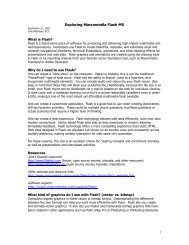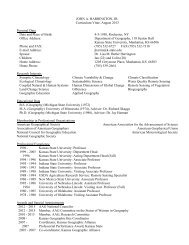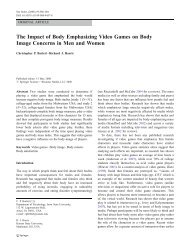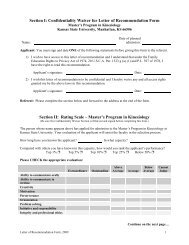Alternate Design Methods for Pedestrian Safety at Roundabout
Alternate Design Methods for Pedestrian Safety at Roundabout
Alternate Design Methods for Pedestrian Safety at Roundabout
You also want an ePaper? Increase the reach of your titles
YUMPU automatically turns print PDFs into web optimized ePapers that Google loves.
<strong>Altern<strong>at</strong>e</strong> <strong>Design</strong> <strong>Methods</strong> <strong>for</strong> <strong>Pedestrian</strong> <strong>Safety</strong> <strong>at</strong> <strong>Roundabout</strong> Entries and Exits: Crash<br />
Studies and <strong>Design</strong> Practices in Australia, France, Gre<strong>at</strong> Britain and the USA<br />
Bill Baranowski, P.E. <strong>Roundabout</strong>sUSA, and Edmund Waddell, Michigan DOT<br />
The paper and present<strong>at</strong>ion discuss study results of pedestrian/vehicle crashes and design practices <strong>at</strong><br />
roundabouts in Australia, France, Gre<strong>at</strong> Britain and the USA. There are conflicting roundabout design<br />
practices among transport<strong>at</strong>ion engineers in the USA, with altern<strong>at</strong>e opinions and claims about the safe<br />
design of entries and exits <strong>for</strong> both single-lane and multi-lane roundabouts. This paper compares two<br />
recent designs constructed in the USA using altern<strong>at</strong>e design methods to reduce travel speeds. The<br />
meeting present<strong>at</strong>ion will illustr<strong>at</strong>e various altern<strong>at</strong>e design applic<strong>at</strong>ions <strong>at</strong> roundabouts currently<br />
oper<strong>at</strong>ing in the USA.<br />
This paper came about as the result of the authors observing roundabout designers in the USA who, in<br />
an <strong>at</strong>tempt to slow exiting traffic to protect pedestrians, have constructed roundabouts with excessively<br />
tight exit radii. This practice has resulted in roundabouts with unnecessarily low capacity and high<br />
vehicle crash r<strong>at</strong>es in some cases. This paper is an opportunity to make the case <strong>for</strong> the design of high<br />
capacity roundabouts th<strong>at</strong> are safe <strong>for</strong> pedestrians.<br />
1. Introduction<br />
<strong>Roundabout</strong>s should be designed to provide adequ<strong>at</strong>e vehicle capacity while reducing vehicle entry,<br />
circul<strong>at</strong>ing, and exit speeds. Reduced speeds in roundabouts benefit both vehicles and pedestrians.<br />
<strong>Pedestrian</strong> safety <strong>at</strong> roundabouts is a function of crash probability and severity. Crash probability rel<strong>at</strong>es<br />
to user <strong>at</strong>tentiveness, decision time, stopping sight distance, and exposure. Severity rel<strong>at</strong>es to vehicle<br />
speed <strong>at</strong> impact.<br />
Adequ<strong>at</strong>e speed reduction is essential prior to crosswalks. Curv<strong>at</strong>ure of the entry p<strong>at</strong>h (R1) reduces<br />
speeds prior to the approach crosswalk, and offers the main opportunity to physically constrain speed <strong>at</strong><br />
th<strong>at</strong> loc<strong>at</strong>ion. For exits, both the entry p<strong>at</strong>h curve (R1) and the circul<strong>at</strong>ing roadway (R2) are prior to the<br />
exit crosswalk, as is part of the exit curve (R3). When speeds are reduced prior to entry and on the<br />
circul<strong>at</strong>ing roadway, speeds also tend to be lower <strong>at</strong> the exits. See Figure 1.<br />
FHWA <strong>Roundabout</strong> In<strong>for</strong>m<strong>at</strong>ional Guide According to the FHWA in<strong>for</strong>m<strong>at</strong>ional guide “achieving<br />
appropri<strong>at</strong>e vehicular speeds through the roundabout is the most critical design objective. A welldesigned<br />
roundabout reduces the rel<strong>at</strong>ive speeds between conflicting traffic streams by requiring<br />
vehicles to negoti<strong>at</strong>e the roundabout along a curved p<strong>at</strong>h. Recommended design speeds vary from<br />
between 15 mph <strong>for</strong> an urban compact single lane roundabout (SLR) to 30 mph <strong>for</strong> a rural Multi Lane<br />
<strong>Roundabout</strong> (MLR).” The design speed of a roundabout is determined from the smallest radius along<br />
the fastest available p<strong>at</strong>h. The entry p<strong>at</strong>h radius R1, the circul<strong>at</strong>ory p<strong>at</strong>h radius R2 and the exit p<strong>at</strong>h<br />
radius R3 are shown in Figure 1. The smallest radius usually occurs on the circul<strong>at</strong>ory roadway as the<br />
vehicle curves to the left around the central island. (1)<br />
The In<strong>for</strong>m<strong>at</strong>ional Guide st<strong>at</strong>es th<strong>at</strong> <strong>at</strong> “single-lane roundabouts with pedestrian activity, exit radii may<br />
still be small (the same or slightly larger than R2) in order to minimize exit speeds. And <strong>at</strong> multi-lane<br />
roundabouts where pedestrians are present, tighter exit curv<strong>at</strong>ure may be necessary to ensure<br />
sufficiently low speeds <strong>at</strong> the downstream pedestrian crossing.”<br />
Australian Recommend<strong>at</strong>ions Australian pedestrian crash studies have been cited as the motiv<strong>at</strong>ion<br />
to build tight exit radii in the United St<strong>at</strong>es. In particular, the following st<strong>at</strong>ement from Tumber 1997 has<br />
been used as a r<strong>at</strong>ionale <strong>for</strong> tight exit radii: “The design of roundabouts should ensure adequ<strong>at</strong>e th<strong>at</strong><br />
1
eduction of vehicle speeds is achieved prior to pedestrian crossing points, to assist in reducing the<br />
severity of injury in the event of a crash with a pedestrian.” The same study found th<strong>at</strong> nearly twice as<br />
many pedestrian crashes (45% vs. 27%) occurred <strong>at</strong> entries as <strong>at</strong> exits. This shows th<strong>at</strong> the probability<br />
of a pedestrian collision (in Melbourne) is nearly twice as high <strong>at</strong> entries than <strong>at</strong> exits, and suggests th<strong>at</strong><br />
speed reduction <strong>at</strong> entries is most critical. (2)<br />
British <strong>Roundabout</strong> <strong>Design</strong><br />
“Adequ<strong>at</strong>e” speed reduction leaves room <strong>for</strong><br />
interpret<strong>at</strong>ion. The designer should consider the<br />
driver’s stopping sight distance and pedestrian<br />
decision and crossing time. The pedestrian<br />
needs to interpret the drivers' intentions (to exit or<br />
circul<strong>at</strong>e) with adequ<strong>at</strong>e time to complete the<br />
crossing. With a relaxed exit p<strong>at</strong>h, the driver's<br />
intentions are apparent to the pedestrian earlier.<br />
The pedestrian crossing is also visible to the<br />
driver earlier, so the stopping sight distance is<br />
improved. If vehicle speed is reduced prior to the<br />
entry, and the Inscribed Circle Diameter (ICD) is<br />
smaller, cars will tend to circul<strong>at</strong>e slower, and if<br />
the pedestrian is clearly visible (as they are on a<br />
more tangential exit), reasonable drivers do not<br />
acceler<strong>at</strong>e <strong>at</strong> them as they begin their exit.<br />
R3: 130 ft<br />
= 23 mph<br />
ICD = 125 ft.<br />
R3: Only 50 ft accel.<br />
distance to Xwalk<br />
R1: Entry Radius<br />
Actual Exit Speed<br />
= 20 mph<br />
R2: 50ft Circ. Radius<br />
= 16 mph<br />
Figure 1: Fastest Vehicle P<strong>at</strong>h and R1, R2 and R3<br />
Exit speed can be calcul<strong>at</strong>ed based on circul<strong>at</strong>ing speed and acceler<strong>at</strong>ion r<strong>at</strong>e, starting from the<br />
circul<strong>at</strong>ing speed <strong>at</strong> the point where drivers round the central island and begin their exit p<strong>at</strong>h curve. A<br />
125 ft. ICD SLR is illustr<strong>at</strong>ed in Figure 1 where R2 slows traffic to 16 mph. The R3 is 130ft. which<br />
suggests a speed of 23 mph <strong>at</strong> the exit crosswalk. However, after vehicles pass R2 they have only 50 ft.<br />
to reach the exit crosswalk and are only able to reach a speed of 20 mph. The speed reduction to 20<br />
mph <strong>at</strong> the exiting crosswalk is due to R1 and R2 and not R3.<br />
The exit radius (the mean radius of the exit) of a MLR determines the exit speed during peak-period<br />
oper<strong>at</strong>ion when traffic is plentiful, and people stay in-lane. However, the fastest p<strong>at</strong>h ignores lane<br />
markings and the fast p<strong>at</strong>h exit radius R3 is usually very much larger than the mean exit geometry. On a<br />
Single Lane <strong>Roundabout</strong> (SLR) with a narrow exit width, R3 and the fastest p<strong>at</strong>h exit radius are nearly<br />
the same. However, if it is a wider single lane exit (to accommod<strong>at</strong>e trucks) R3 can be surprisingly larger<br />
than the radius of the exit geometry.<br />
On a Multi-Lane <strong>Roundabout</strong> (MLR) with a two or three-lane exit, R3 is much larger than the exit<br />
geometry radius. Consequently, during peak-periods with lots of traffic (when most pedestrians are<br />
present) drivers stay in their lanes on MLR exits, and speeds are low. Speeds are usually gre<strong>at</strong>est<br />
during fast-p<strong>at</strong>h oper<strong>at</strong>ion <strong>at</strong> off-peak periods when vehicles are scarce (and pedestrians are scarce).<br />
2
Off-peak, the fastest-p<strong>at</strong>h exit speed depends not on R3 (too large to have any effect) but on the<br />
following:<br />
• The circul<strong>at</strong>ory radius, R2 ;<br />
• The distance from the end of the R2 radius to the exit crosswalk; and<br />
• The acceler<strong>at</strong>ion from the end of R2 to the exit crosswalk.<br />
This assumes th<strong>at</strong> drivers acceler<strong>at</strong>e immedi<strong>at</strong>ely as they reach the end of R2. (This is very aggressive<br />
and usually there is a time lag.) The acceler<strong>at</strong>ion r<strong>at</strong>e is about 3.5 ft/sec/sec (it may vary depending on<br />
the initial R2 speed).<br />
Using Newton's' equ<strong>at</strong>ion <strong>for</strong> speed and acceler<strong>at</strong>ion:<br />
2<br />
V f = U 2 + 2aS Where: V f = Final Speed<br />
U = Initial R2 Speed<br />
a = Acceler<strong>at</strong>ion<br />
S = Distance<br />
Sometimes the R1 speed can be so low th<strong>at</strong> R2 speed is not achieved, so this will be lower than the<br />
speed indic<strong>at</strong>ed by the R2 radius, especially if the ICD is small as the distance from R1 to R2 is small.<br />
The smaller the ICD, the harder it is to keep R1 small. More interestingly, R2 is strange because with a<br />
small ICD, R2 can be large as it skims the central island on a fl<strong>at</strong> trajectory. As the ICD is increased, the<br />
enlarged central island bends R2, so it gets smaller. Further increasing the ICD reduces R2 until the<br />
point is reached when R2 is the same as the central island radius. From this point onwards, increasing<br />
the ICD increases R2, which increases the overall design speed. (3)<br />
2. <strong>Roundabout</strong> Entry/Exit <strong>Design</strong> Examples in the USA<br />
The following two examples illustr<strong>at</strong>e critical differences in design of roundabout entries and exits. The<br />
Okemos roundabout was designed first with tight exit methods, but with British design methods carried<br />
<strong>for</strong>ward to construction. The Clearw<strong>at</strong>er Beach roundabout was designed using tight exit methods<br />
through construction, with l<strong>at</strong>er changes using British methods to reduce crashes.<br />
Okemos <strong>Roundabout</strong> – Ingham County, Michigan<br />
Exit speed can be calcul<strong>at</strong>ed based on circul<strong>at</strong>ing speed and acceler<strong>at</strong>ion r<strong>at</strong>e, starting from the<br />
circul<strong>at</strong>ing speed <strong>at</strong> the point where drivers round the central island and begin their exit p<strong>at</strong>h curve. The<br />
Okemos, Michigan roundabout shown below was designed following tight exit guidelines shown in<br />
Figure 3 and following British guidelines shown in Figure 4. The calcul<strong>at</strong>ed exit speed <strong>at</strong> the eastbound<br />
exit <strong>for</strong> both designs is 18 MPH. The constructed roundabout, shown in Figures 5 and 6, followed the<br />
British design with exit speeds measured <strong>at</strong> 15-20 mph. The crossing "feels" very safe, and there have<br />
been no pedestrian crashes or complaints between 2000 and 2003.<br />
3
Figure 2. Okemos: Existing Intersection – Traffic Signal<br />
• Old Stop –controlled intersection had delays on side<br />
street.<br />
• Install<strong>at</strong>ion of a signal resulted in injury crashes and<br />
poor signal coordin<strong>at</strong>ion with nearby signal (to the<br />
west), due to high left-turn percentage.<br />
Figure 3. Okemos: Tight Exit Radii <strong>Design</strong><br />
• Low circul<strong>at</strong>ing flows.<br />
• Minimal queues and delays predicted.<br />
• Stopping sight distance west to east is substandard.<br />
• Dangerous “see-through” problem.<br />
• Move roundabout as far south as possible to:<br />
- Provide adequ<strong>at</strong>e stopping sight distance;<br />
- Remove see-through problem.<br />
• Large deflection on approach minimizes speeds<br />
inside the circle.<br />
• Small ICD has short acceler<strong>at</strong>ion distances to the<br />
exits.<br />
• Low exit speed (18 mph) <strong>for</strong> pedestrian safety.<br />
Figure 4. Okemos: British Style Re-<strong>Design</strong><br />
Large Deflection, 2-Lane Entry and Tangential Exits<br />
Figure 5. Okemos: Looking Westbound<br />
(Photo courtesy Ingham County Road Commission)<br />
Figure 6. Okemos: Looking Southbound<br />
(Photo courtesy Ingham County Road Commission)<br />
4
Clearw<strong>at</strong>er Beach <strong>Roundabout</strong> - Clearw<strong>at</strong>er, Florida<br />
The Clearw<strong>at</strong>er Beach roundabout is described here because it has received a significant amount of<br />
neg<strong>at</strong>ive publicity and is often referred to by roundabout naysayers when explaining why roundabouts<br />
will not work in heavy traffic. It is also a classic example of tight exit radii design.<br />
I. The Original <strong>Design</strong><br />
The design of the Clearw<strong>at</strong>er <strong>Roundabout</strong><br />
completed in 2000 was uncommonly complex. It<br />
converted 5 intersections into one intersection th<strong>at</strong><br />
had to accommod<strong>at</strong>e Spring Break traffic volumes<br />
of 56,000 vehicles and 6,000 pedestrians per day.<br />
The desires of the Landscape Architects and the<br />
Fountain <strong>Design</strong>ers also contributed to the design<br />
complexity. The design sought to find the best<br />
balance between these unavoidably conflicting<br />
aims.<br />
Figure 7. Clearw<strong>at</strong>er Beach <strong>Roundabout</strong> After<br />
Striping and Curb Changes<br />
(Photo courtesy Ken Sides)<br />
II. Resulting Crash Experience<br />
The roundabout had a large number of vehicle<br />
crashes <strong>at</strong> the 2-lane exits onto the Causeway and<br />
<strong>at</strong> the exit onto Coronado Drive. Many of those<br />
crashes involved cars continuing around the circle<br />
in the right lane colliding with drivers exiting from<br />
the left lane. However, there have been no<br />
pedestrian crashes <strong>at</strong> the roundabout. This clearly<br />
reveals th<strong>at</strong> the best balance between vehicle<br />
capacity and pedestrian safety was not initially<br />
achieved.<br />
III. Striping Changes and Reduction in Crashes<br />
In July 2001, the revisions shown in Figure 7 were made following British practices. The changes<br />
included revisions to curbs, signing, striping, and lane arrows were introduced th<strong>at</strong> resulted in a<br />
significant drop in number of crashes. For example, <strong>at</strong> the Causeway exit crashes dropped from a high<br />
of 25 per month. At last report, there have been no crashes <strong>at</strong> this loc<strong>at</strong>ion since the changes were<br />
made. This clearly demonstr<strong>at</strong>es th<strong>at</strong> the fault was with design detail and not the drivers. To resolve the<br />
crash problem <strong>at</strong> the Causeway exit and the Mandalay exit the curbs were realigned to cre<strong>at</strong>e wider and<br />
more relaxed exit radii.<br />
5
3. Review of <strong>Pedestrian</strong> Crash Studies: in France, Australia, and Gre<strong>at</strong><br />
Britain<br />
<strong>Pedestrian</strong> Crash Study in France<br />
In 1990, 202 crashes were investig<strong>at</strong>ed <strong>at</strong> 179 urban roundabouts in France. Table 2 shows the rel<strong>at</strong>ive<br />
frequency of the different causes of these crashes. (4)<br />
The major design recommend<strong>at</strong>ions derived from the above study are:<br />
• Ensure motorists recognize the approach to the roundabout;<br />
• Avoid entries and exits with two or more lanes except <strong>for</strong> capacity requirements;<br />
• Separ<strong>at</strong>e the exit and entry by a splitter island;<br />
• Avoid perpendicular entries or very large radii;<br />
• Avoid very tight exit radii ; and<br />
• Avoid oval-shaped roundabouts.<br />
Table 2<br />
Causes of <strong>Roundabout</strong> Crashes in France (4)<br />
Cause of Crash<br />
Percent of Crashes<br />
Entering traffic failing to yield to circul<strong>at</strong>ing traffic 36.6%<br />
Loss of control inside the circul<strong>at</strong>ory roadway 16.3%<br />
Loss of control <strong>at</strong> entries 10.0%<br />
Rear-end crashes <strong>at</strong> entries 7.4%<br />
Sideswipe, mostly <strong>at</strong> two-lane exits with cyclists 5.9%<br />
Running over pedestrians <strong>at</strong> marked crosswalks,<br />
mostly <strong>at</strong> two-lane entries 5.9%<br />
<strong>Pedestrian</strong>s on the circul<strong>at</strong>ory roadway 3.5%<br />
Loss of control <strong>at</strong> exits 2.5%<br />
Head on collision <strong>at</strong> exits 2.5%<br />
Weaving inside the circul<strong>at</strong>ory roadway 2.5%<br />
<strong>Pedestrian</strong> Casualty Study in Australia<br />
A 1982 Victorian <strong>Pedestrian</strong> Casualty Study reported by Jordan evalu<strong>at</strong>ed 31 pedestrian crashes from<br />
1980-1983. The study found one pedestrian crash per 100 roundabout years. Of crashes th<strong>at</strong> occurred<br />
in crosswalks, 78% occurred as the pedestrian began the crossing, with 22% as they left the splitter<br />
island. Of all pedestrian crashes, 39% were on entries, 35% were on exits, 16% were on the circul<strong>at</strong>ing<br />
roadway and 10% other. (5)<br />
6
Jordan offers several recommend<strong>at</strong>ions <strong>for</strong> pedestrian crossings (paraphrasing):<br />
• Reduce vehicle approach speeds by providing adequ<strong>at</strong>e deflection on each approach.<br />
• Provide splitter islands as large as the site allows.<br />
• Provide clearly defined carriage and splitter island crossings.<br />
• Prohibit parking on approaches to improve visibility of pedestrians.<br />
• Assure street lighting illumin<strong>at</strong>es the roundabout and the approaches.<br />
• Loc<strong>at</strong>e signs so users perceive an easily recognizable intersection layout.<br />
• Loc<strong>at</strong>e signs and landscaping so th<strong>at</strong> signs, pedestrians and bicyclists are not hidden.<br />
A 1997 study by Tumber evalu<strong>at</strong>ed 64 pedestrian crashes <strong>at</strong> 38 Melbourne roundabouts from 1987-<br />
1994. The study found 45% of the pedestrian crashes were <strong>at</strong> entries, 27% <strong>at</strong> exits, 17% on the<br />
circul<strong>at</strong>ing roadway, 3% on the footp<strong>at</strong>h or splitter, and 8% <strong>at</strong> other loc<strong>at</strong>ions. (This d<strong>at</strong>a suggests th<strong>at</strong><br />
vehicle speed reduction is nearly twice as important <strong>at</strong> entries as <strong>at</strong> exits). No d<strong>at</strong>a was available <strong>for</strong><br />
pedestrian or vehicle volume, however pedestrian crashes were more common in commercial precincts<br />
where pedestrians were most frequent. <strong>Pedestrian</strong> injuries were less severe <strong>at</strong> roundabouts than <strong>at</strong> all<br />
other intersection types. (2)<br />
Tumber offers six recommend<strong>at</strong>ions <strong>for</strong> pedestrian safety:<br />
• Assure adequ<strong>at</strong>e vehicle speed reduction prior to pedestrian crossings.<br />
• Set pedestrian crossings one-to-two car lengths back from yield lines so drivers encounter<br />
pedestrian and vehicle conflicts as separ<strong>at</strong>e tasks.<br />
• Provide space on the splitter island <strong>for</strong> carriages, wheelchairs, etc., and make crossings flush<br />
with the pavement or as low as possible.<br />
• Assure curbs cuts and splitter island crossings are in alignment.<br />
• Assure visibility <strong>for</strong> pedestrians to see oncoming vehicles from all crossing points, and <strong>for</strong> drivers<br />
to see all crossing points from each approach.<br />
• Use physical measures to discourage inappropri<strong>at</strong>e pedestrian movements and direct pedestrian<br />
to crosswalks.<br />
<strong>Pedestrian</strong> Crash Studies in Gre<strong>at</strong> Britain<br />
A 1975 study by Lalani reported be<strong>for</strong>e-and-after crash experience from 38 intersections converted to<br />
roundabouts between January 1970 and May 1975. <strong>Pedestrian</strong> crashes within 50 meters (165’) of<br />
the intersection were included in the study, and these dropped 46.2% after conversion to<br />
roundabouts, with f<strong>at</strong>al and serious pedestrian crashes down 70.0%. At mini-roundabouts,<br />
pedestrian crashes dropped 37.5%, and f<strong>at</strong>al/serious pedestrian crashes dropped 60%. The study did<br />
not provide d<strong>at</strong>a on pedestrian or vehicle volumes, and did not offer specific design guidance, but<br />
recommended roundabouts as an intersection safety measure, with raised islands where practical. (6)<br />
In 1984, the Transport and Road Research Labor<strong>at</strong>ory and Southampton University evalu<strong>at</strong>ed 431<br />
junction-years of injury crash d<strong>at</strong>a, encompassing 1,427 crashes <strong>at</strong> 84 four-leg roundabouts. D<strong>at</strong>a was<br />
collected on pedestrian and traffic volumes, intersection geometry, and crash type, and analyzed<br />
through multivari<strong>at</strong>e regression to determine the variables which predicted crashes of each type -<br />
7
including pedestrian crashes, which were 5.5% of the total (78 crashes). <strong>Pedestrian</strong> volume d<strong>at</strong>a was<br />
available <strong>for</strong> 60 pedestrian crashes, <strong>at</strong> fifty roundabouts within 30-40 MPH speed zones.<br />
The TRL study found no significant rel<strong>at</strong>ionship between geometry and pedestrian crashes. They<br />
developed a <strong>for</strong>mula <strong>for</strong> pedestrian crashes rel<strong>at</strong>ed only to traffic and pedestrian flows:<br />
A=.029 (Q V Q P ) 0.5<br />
Where:<br />
A = Annual <strong>Pedestrian</strong> Injury Crashes <strong>for</strong> a <strong>Roundabout</strong> Leg<br />
Q V = Entering + Exiting vehicle ADT (in thousands)<br />
Q P = Average Daily <strong>Pedestrian</strong> Crossing Volume (in thousands)<br />
Although the report rel<strong>at</strong>es crashes to volume only and does not provide design recommend<strong>at</strong>ions <strong>for</strong><br />
roundabout pedestrian crossings, some geometric factors are implicit in the TRL <strong>for</strong>mula. For example,<br />
vehicle entering and exiting volumes strongly rel<strong>at</strong>e to entry and exit width. Since higher volume roads<br />
tend to be wider, pedestrians require more time to walk across. There<strong>for</strong>e, the TRRL equ<strong>at</strong>ion rel<strong>at</strong>es<br />
pedestrian crashes to both vehicle volume and pedestrian crossing time (exposure). This does not st<strong>at</strong>e<br />
th<strong>at</strong> other rel<strong>at</strong>ionships between geometry and pedestrian crashes do not exist, only th<strong>at</strong> the crash d<strong>at</strong>a<br />
did not reveal a significant rel<strong>at</strong>ionship between pedestrian crashes and roundabout geometry. (7)<br />
4. Conclusions<br />
1. Tight-exit versus relaxed-exit designs were compared <strong>at</strong> the Okemos and Clearw<strong>at</strong>er Beach<br />
roundabouts.<br />
2. Tight-exit design shows little benefit <strong>for</strong> pedestrians by reducing speed, and in some cases may<br />
endanger them by limiting sight-distance <strong>for</strong> drivers.<br />
3. Studies in both Australia and France show th<strong>at</strong> most pedestrian crashes occur <strong>at</strong> roundabout entries,<br />
not exits.<br />
4. No rel<strong>at</strong>ionship has been reported between pedestrian crashes and exit radius.<br />
5. Both British and Australian roundabout accident studies show significant reduction in pedestrian<br />
accidents after roundabouts are installed. <strong>Pedestrian</strong> accident r<strong>at</strong>es increase with traffic volumes and<br />
pedestrian volumes. As pedestrian/vehicle crossing conflicts increase, crosswalk tre<strong>at</strong>ments should<br />
be improved accordingly and may warrant grade separ<strong>at</strong>ion <strong>for</strong> some roundabout loc<strong>at</strong>ions.<br />
6. <strong>Design</strong>ed correctly, easy roundabout exits can improve roundabout capacity and reduce vehicle<br />
crashes, without increasing exit speeds or harming pedestrians.<br />
Since 1990, about 300 modern roundabouts have been built in the United St<strong>at</strong>es. Almost all have been<br />
unqualified successes. A study by the Insurance Institute <strong>for</strong> Highway <strong>Safety</strong> determined th<strong>at</strong><br />
roundabouts in the United St<strong>at</strong>es have reduced all crash types by 40% and injury crashes by 80%, <strong>at</strong><br />
sites where they replaced other types of intersections. We do not know of any other type of highway<br />
improvement th<strong>at</strong> has such a high success r<strong>at</strong>e.<br />
Considering th<strong>at</strong> USA traffic engineers are very inexperienced <strong>at</strong> roundabout design, it is to our credit<br />
th<strong>at</strong> the failure r<strong>at</strong>e so far has been only a few percent. This is exemplified by public opinion in the USA:<br />
8
typically 80-90% against building a roundabout when it is proposed, but 80-90% in favor after<br />
construction. The lesson to be learned from the few failures in the USA is not th<strong>at</strong> roundabouts in<br />
general do not work here, but th<strong>at</strong> roundabout design is difficult, errors can lead to failure, and good<br />
design produces roundabouts th<strong>at</strong> are safer than any other type of <strong>at</strong>-grade intersection. “Would-be”<br />
roundabout designers should be well advised get experienced assistance be<strong>for</strong>e <strong>at</strong>tempting to design a<br />
roundabout.<br />
Author In<strong>for</strong>m<strong>at</strong>ion:<br />
Bill Baranowski, P.E.<br />
<strong>Roundabout</strong>sUSA<br />
715 East 3950 North<br />
Provo, UT 84604<br />
Email: bill@<strong>Roundabout</strong>sUSA.com<br />
Edmund Waddell, Senior Transport<strong>at</strong>ion Planner<br />
Michigan DOT Project Planning Division<br />
425 W. Ottawa St.<br />
Lansing, MI 48909<br />
Email: Waddelle@michigan.gov<br />
REFERENCES<br />
1. <strong>Roundabout</strong>s: An In<strong>for</strong>m<strong>at</strong>ional Guide. Report FHWA-RD-00-67. FHWA, U.S. Department of<br />
Transport<strong>at</strong>ion, Washington DC, 2000.<br />
2. Tumber, C: Review of <strong>Pedestrian</strong> <strong>Safety</strong> <strong>at</strong> <strong>Roundabout</strong>s, Vic Roads, Road <strong>Safety</strong> Department,<br />
Melbourne , AU, April 1997.<br />
3. Barry Crown, Staf<strong>for</strong>dshire, UK.<br />
4. B. Guichet. "Classific<strong>at</strong>ion of Accidents on Urban <strong>Roundabout</strong>s," Actes du Seminaire "Gir<strong>at</strong>oires 92,"<br />
Nantes, France, Oct. 14-16, 1992. Research conducted by the Center <strong>for</strong> Technical Studies of the<br />
Western Facilities, Nantes, France.<br />
5. Jordan, P.W.: <strong>Pedestrian</strong>s and Cyclists <strong>at</strong> <strong>Roundabout</strong>s, Third N<strong>at</strong>ional Local Government<br />
Engineering Conference, Institution of Engineers, Melbourne, AU, August 1985<br />
6. Lalani, N., The impact on accidents of the introduction of mini, small, and large roundabouts <strong>at</strong><br />
major/minor priority junctions, Traffic Engineering and Control, London, UK, Dec 1975, pg 560-561.<br />
7. G. Maycock and R.D. Hall. Accidents <strong>at</strong> 4-Arm <strong>Roundabout</strong>s, Transport and Road Research<br />
Labor<strong>at</strong>ory, Crowthorne, UK, 1984.<br />
Exit Speeds and R1, R2, and R3<br />
Exit speed needs to be controlled<br />
Fast exit speed is dangerous <strong>for</strong> pedestrians<br />
How can exit speed be controlled<br />
It is generally accepted:<br />
-th<strong>at</strong> small exit radii controls exit speed<br />
-says so in most liter<strong>at</strong>ure<br />
-it is very plausible<br />
However things are not always as they seem<br />
Exit<br />
R3<br />
275ft vehicle p<strong>at</strong>h<br />
radius = 30mph<br />
50ft Radius Curb = 16 mph <br />
R2 Circ. Radius<br />
Entry R1<br />
9
Single Lane <strong>Roundabout</strong> - 125 ft. ICD<br />
Medium sized 125 ft. ICD single-lane roundabout<br />
If exit width (curb face to curb face) is small (13ft.)<br />
-Small exit radius will control exit speeds<br />
-R3 the exit p<strong>at</strong>h radius is similar to the exit radius<br />
However if trucks are to be accommod<strong>at</strong>ed<br />
Exit width needs to be <strong>at</strong> least 17 ft. wide<br />
The exit radius is now not so effective<br />
The exit p<strong>at</strong>h radius R3 is larger than the exit radius<br />
The exit radius suggests a 16mph speed.<br />
R3 suggests a 23 mph exit speed.<br />
However the central p<strong>at</strong>h radius R2 has an effect.<br />
R2 is 50 ft and suggests 16 mph.<br />
The acceler<strong>at</strong>ion distance, R2 to crosswalk is 50ft.<br />
- FHWA Guide gives 3.4 ft /second acceler<strong>at</strong>ion.<br />
This gives an exit speed of only 20 mph.<br />
Exit speed on wide single exits is controlled by R2 .<br />
Not controlled by the exit radius or by R3.<br />
130ft Radius = 23mph<br />
R3<br />
50ft Radius Curb = 16 mph <br />
R2 = 50ft<br />
2 Lane <strong>Roundabout</strong> - 165 ft. ICD<br />
If exit width curb face to curb face large (23-28ft.).<br />
Small exit radius will not control exit speeds.<br />
R3 the exit p<strong>at</strong>h radius much larger than the exit radius.<br />
When vehicles exit two abreast speeds are lower.<br />
Small exit radii causes exit overlap and exit crashes.<br />
Small exit radii must not be used on MLRs.<br />
MLR Exit Speed - 165 ft. ICD<br />
The exit radius suggests a 16 mph exit speed.<br />
R3 suggests a 30 mph exit speed.<br />
Again the central p<strong>at</strong>h radius R2 has an effect.<br />
This is 95ft and suggests 20 mph.<br />
There is 80ft acceler<strong>at</strong>ion distance to the crosswalk.<br />
FHWA Guide gives 3.4 ft/second acceler<strong>at</strong>ion.<br />
This gives an exit speed of 25 mph.<br />
Exit speed is there<strong>for</strong>e controlled by R2.<br />
NOT by the exit radius or R3.<br />
They do not control exit speeds effectively.<br />
Cause exit crashes.<br />
275ft vehicle p<strong>at</strong>h<br />
radius = 30mph<br />
R3<br />
50ft Radius Curb = 16 mph <br />
R2 = 95 ft = 20 mph<br />
10
Exit P<strong>at</strong>h Overlap<br />
On a two-lane exit two vehicles can exit together.<br />
They must there<strong>for</strong>e stay in-lane and speeds are low.<br />
Small exit radii cause exit lane overlapping.<br />
This causes exit crashes.<br />
R2<br />
Clearw<strong>at</strong>er <strong>Roundabout</strong> had 600 exit crashes<br />
Exit p<strong>at</strong>h overlap was one of the causes.<br />
Relaxing exit radii has reduced exit crashes dram<strong>at</strong>ically. Small Exit Radii = Exit Overlap<br />
BALANCE IS NEEDED<br />
Larger exit radii to avoid vehicle crashes<br />
Slow speeds on entry <strong>at</strong> R1<br />
Slow speeds into exit with R2<br />
Small ICD makes distance between R2 and crosswalk short<br />
Larger radius gives good view: Ped Car<br />
Exit speeds = about 25 mph with good visibility<br />
Exit Speed = 25 mph<br />
95ft p<strong>at</strong>h radius = 20 mph<br />
210ft p<strong>at</strong>h radius = 27 mph<br />
80 ft accel distance = 25mph<br />
Crosswalks<br />
UK roundabouts have ~50% less pedestrian crashes than traffic signals.<br />
There is a UK warrant <strong>for</strong> installing a Signalized crosswalk. PV 2<br />
P is pedestrians crossing/hr, V is vph<br />
If PV 2 >10 8 then a signalized crossing is warranted.<br />
At a roundabout with a splitter Island there are two crosswalks so each has to s<strong>at</strong>isfy the warrant criteria.<br />
The pedestrians cross both so P is the same, but V will be different, the entry flows on one and the exit<br />
flows on the other.<br />
When pedestrian volumes are significant they can hamper the roundabout capacity on a un-signalized<br />
crosswalk as single pedestrians stop the traffic.<br />
Signalized crosswalks can be set to give a good split <strong>for</strong> both vehicle traffic and pedestrians.<br />
Crossing the pedestrians in groups is more visible also.<br />
With signalized crosswalks drivers tend to w<strong>at</strong>ch the signals r<strong>at</strong>her than the pedestrians just like <strong>at</strong><br />
normal traffic signals.<br />
11
Clearw<strong>at</strong>er Beach Mother of All <strong>Roundabout</strong>s Today as of March 2003:<br />
During Spring Break, traffic approaches 4,000 vph and around 1,000 pedestrians/hour use the two major<br />
crosswalks shown below. Photo <strong>at</strong> left shows new crosswalk loc<strong>at</strong>ion and old loc<strong>at</strong>ion in faint paint.<br />
12
















